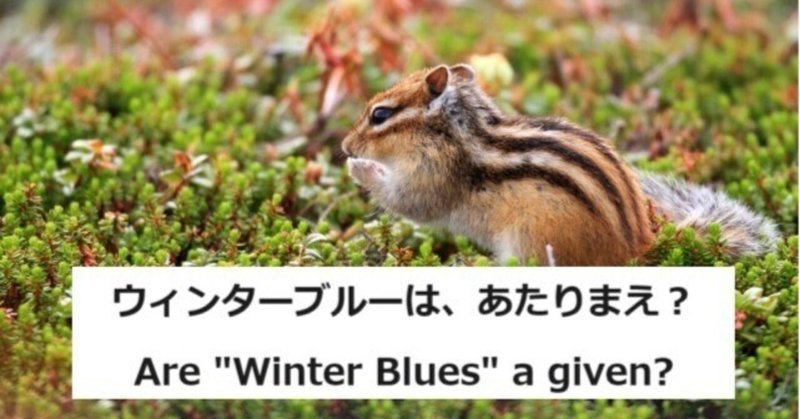
「ウィンターブルー」は、あたりまえ?Are "Winter Blues" a given?
ウィンターブルーとは
日が暮れるのが早くなる秋から冬にかけて、気分が落ち込みやすくなり、なんとなくやる気が出ない症状をウィンターブルー(冬季うつ病)と呼びます。せっかくハロウィンで街中が盛り上がっているのに、なんとなく人に会いたくない、なんて消極的な気分になるのは、実は、人間なら自然な反応です。
人間も冬眠していたのではないか
というのも、私たち人間もかつては、冬眠をしていたらしいのです。スペイン北部のアタプエルカの遺跡にある洞窟で発掘された人骨から、大昔の人類が冬眠する動物と同じように骨の成長が止まっていた跡が証拠としてあるのです。また、今の時代のように暖房設備が整っていない時代には、極寒の冬を越すために、1日中暖炉の近くで寝て過ごした民族もいたというのも不思議ではないですね。
霊長類も冬眠する
シマリスやヒグマやヘビなどは冬眠することが知られています。冬眠することによって、カラダが熱をつくるのを休止し、エネルギーの節約をします。エネルギーがつくられないと、体温も下がり、心拍数も減少し、「冬眠」状態になります。冬眠する動物たちは、積極的に「寝て過ごす」ことで寒くて厳しい冬を乗り切ります。動物の冬眠で興味深いのは、霊長類も冬眠をするのです。例えば、ハイイロネズミキツネザルというマダガスカルに生息する可愛いサルも冬眠します。平均気温が20度ぐらいのマダガスカルで冬眠する動物がいるのも驚きです。
冬眠することで、若返る
もうひとつ、動物の眠りで面白い話があります。シマリスとラットは、同じようなサイズで、カラダの小さい動物です。シマリスは冬眠をしますが、ラットはもともと冬眠をしません。見た目も大きさも似ているこれら2種の小動物ですが、シマリスは平均寿命が11年で、ラットは3年です。動物の寿命はカラダの大きさの関連することが多いのですが、どうやら冬眠も影響を与えているようです。シマリスは冬眠をしている間は歳をとらないだけではなく、若返っている可能性もあるそうです。
活動的になる春への準備
寒くて日照時間が短い冬にしっかりと冬眠して乗り過ごす動物たちは、暖かくなる春の活動しやすい季節には、活発に動きまわることができます。冬眠は、厳しい自然環境に対応するための生き物の知恵なのです。現代の人間は、まとまった冬眠はしませんが、大昔の冬眠のなごりとしてウィンターブルーが起こるのは自然現象です。そう考えれば、ウィンターブルーは病気ではなく、むしろ健康なカラダの反応なのかもしれません。これから寒くなる季節には、無理して活動しなくてもよいのです。来る春に向けて、寒い冬を乗り切りましょう。動物の冬眠行動から、気分が落ち込みがちのウィンターブルーなジブンを受け入れるのもいいですね。
Are "Winter Blues" a given?
What are Winter Blues?
Winter blues (winter depression) are symptoms of feeling depressed and unmotivated during the fall and winter months, when the days get darker earlier. It is actually a natural reaction of human beings to feel reluctant to meet people, even though the town is filled with excitement during Halloween.
I wonder if humans have been hibernating as well?
It is said that we humans used to hibernate, too. Human bones excavated from a cave in the Atapuerca archaeological site in northern Spain show evidence that human bones stopped growing long ago, just as hibernating animals do. It is also not surprising that some peoples spent the entire day sleeping near a fireplace in order to survive the extremely cold winter, when heating systems were not as well equipped as they are today.
Primates also hibernate.
Chipmunks, brown bears, and snakes are known to hibernate. By hibernating, the body suspends heat production to conserve energy. When energy is not being produced, the body temperature drops and the heart rate decreases, resulting in a state of "hibernation". Hibernating animals survive the cold, harsh winters by actively "sleeping it off". What is interesting about animal hibernation is that primates also hibernate. For example, a cute little monkey living in Madagascar called the gray mouse lemur also hibernates. It is surprising that some animals hibernate in Madagascar, where the average temperature is around 20 degrees Celsius.
Does hibernation rejuvenate you?
There is another interesting story about animal sleep. Chipmunks and rats are similarly sized, small-bodied animals. Chipmunks hibernate, but rats do not hibernate by nature. Although these two small animals are similar in appearance and size, the average lifespan of a chipmunk is 11 years while a rat's lifespan is 3 years. Animal lifespan is often related to body size, but hibernation also seems to have an effect. Chipmunks not only do not age during hibernation, but they may also be rejuvenated.
Preparation for spring
When they become more active animals that hibernate well through the cold and short daylight hours of winter are able to move around more actively during the warmer and more active season. Although we humans today do not hibernate in large numbers, the occurrence of winter blues are a natural phenomenon that is a remnant of hibernation in ancient times. In this sense, winter blues may not be a sickness, but rather a response of a healthy body. During the cold season, there is no need to force yourself to be active. Let's get through the cold winter in preparation for the coming spring. It is also a good idea to embrace the winter blues that tend to make us feel depressed, inspired by the hibernating behavior of animals.
この記事が気に入ったらサポートをしてみませんか?
